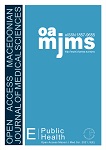Point of Care Ultrasound Use by Interns in Emergency Department
DOI:
https://doi.org/10.3889/oamjms.2021.6380Keywords:
Ultrasonography, General practitioners, Emergency departmentAbstract
BACKGROUND: Point of care ultrasound (POCUS) is required for use in many instances on a daily basis in the hospital, especially in the emergency department and other specialty treatment areas. While interns play a crucial role in running emergency services in Thailand, the POCUS usage of interns has not been well studied.
METHODS: This was a retrospective observational study of the interns who worked at the Department of Emergency Medicine, a tertiary university hospital in Khon Kaen, Thailand between July 2020 and April 2021. The seven questions survey about participants’ experiences performing POCUS examinations was conceived and carried out by the research team. The primary aim of this study is to identify the frequency of POCUS examinations performed by interns in this or any other given rotation.
RESULTS: The response rate was 81.25% with the frequency of POCUS examinations per physician coming in at 2.5 per shift. It should be noted that examinations occurred primarily during the morning shift (79%) and were for diagnostic purposes (100%). The highest POCUS use cases (80%) were found to take place for abdominal examinations and the most commonly used POCUS application was the FAST (Focused Assessment with Sonography for Trauma) examination (92%). The confidence level was rated as 3/5. The primary barrier to performing POCUS was lack of knowledge or ultrasound training (47%).
CONCLUSIONS: POCUS is often used by interns though less than in some other specialties. The type of POCUS application employed was limited due to lack of training and the primary obstacle for POCUS use in the emergency department was patient overcrowding.
Downloads
Metrics
Plum Analytics Artifact Widget Block
References
Weile J, Brix J, Moellekaer AB. Is point-of-care ultrasound disruptive innovation? Formulating why POCUS is different from conventional comprehensive ultrasound. Crit Ultrasound J. 2018;10(1):25. https://doi.org/10.1186/s13089-018-0106-3 PMid:30270416 DOI: https://doi.org/10.1186/s13089-018-0106-3
Steinmetz P, Oleskevich S. The benefits of doing ultrasound exams in your office. J Fam Pract. 2016;65(8):517-23. PMid:27660835
Genc A, Ryk M, Suwała M, Żurakowska T, Kosiak W. Ultrasound imaging in the general practitioner’s office-a literature review. J Ultrason. 2016;16(64):78-86. PMid:27104005 DOI: https://doi.org/10.15557/JoU.2016.0008
Mengel-Jørgensen T, Jensen MB. Variation in the use of point-of-care ultrasound in general practice in various European countries. Results of a survey among experts. Eur J Gen Pract. 2016;22(4):274-7. https://doi.org/10.1080/13814788.2016.1211105 PMid:27487159 DOI: https://doi.org/10.1080/13814788.2016.1211105
Lindgaard K, Riisgaard L. Validation of ultrasound examinations performed by general practitioners. Scand J Prim Health Care. 2017;35(3):256-61. https://doi.org/10.1080/02813432.2017.135 8437 PMid:28776457 DOI: https://doi.org/10.1080/02813432.2017.1358437
Bratland SZ. Ultrasonic diagnosis used in general practice. A summarized evaluation. Tidsskr Nor Laegeforen. 1985;105(28):1954-5. PMid:3907006
Chan VS, Piterman L, McCall L. Use of clinical ultrasonography in an Australian suburban family practice: Its indications and findings. Hong Kong Practitioner. 1999;21(9):405-15. PMid:30670398
Szwamel K, Polanski P, Kurpas D. Experiences of family physicians after a CME ultrasound course. Fam Med Prim Care Rev. 2017;19(1):62-9. https://doi.org/10.5114/fmpcr.2017.66666 DOI: https://doi.org/10.5114/fmpcr.2017.66666
Wordsworth S, Scott A. Ultrasound scanning by general practitioners: Is it worthwhile? J Public Health Med. 2002;24(2):88-94. https://doi.org/10.1093/pubmed/24.2.88 PMid:12141591 DOI: https://doi.org/10.1093/pubmed/24.2.88
Olgers TJ, Azizi N, Bouma HR, Ter Maaten JC. Life after a point-of-care ultrasound course: Setting up the right conditions? Ultrasound J. 2020;12(1):43. https://doi.org/10.1186/s13089-020-00190-7 PMid:32893335 DOI: https://doi.org/10.1186/s13089-020-00190-7
Leschyna M, Hatam E, Britton S, Myslik F, Thompson D, Sedran R, et al. Current state of point-of-care ultrasound usage in Canadian emergency departments. Cureus. 2019;11(3):e4246. https://doi.org/10.7759/cureus.4246 PMid:31131169 DOI: https://doi.org/10.7759/cureus.4246
Aakjær Andersen C, Brodersen J, Davidsen AS, Graumann O, Jensen MB. Use and impact of point-of-care ultrasonography in general practice: A prospective observational study. BMJ Open. 2020;10(9):e037664. https://doi.org/10.1136/bmjopen-2020-037664 PMid:32948563 DOI: https://doi.org/10.1136/bmjopen-2020-037664
Ienghong K, Towsakul N, Bhudhisawasdi V, Srimookda N, Ratanachotmanee N, Phungoen P. POCUS findings in critically Ill patients in emergency department. J Med Assoc Thai. 2021;104:54-8. DOI: https://doi.org/10.35755/jmedassocthai.2021.S01.12228
Gardner KF, Clattenburg EJ, Wroe P, Singh A, Mantuani D, Nagdev A. The cardiac arrest sonographic assessment (CASA) exam-a standardized approach to the use of ultrasound in PEA. Am J Emerg Med. 2018;36:729-31. https://doi.org/10.1016/j.ajem.2017.08.052 PMid:28851499 DOI: https://doi.org/10.1016/j.ajem.2017.08.052
Kedan I, Ciozda W, Palatinus JA, Palatinus HN, Kimchi A. Prognostic value of point-of-care ultrasound during cardiac arrest: A systematic review. Cardiovasc Ultrasound. 2020;18:1. https://doi.org/10.1186/s12947-020-0185-8 PMid:31931808 DOI: https://doi.org/10.1186/s12947-020-0185-8
Ienghong K, Kleebbuakwan K, Apiratwarakul K, Phungoen P, Gaysonsiri D, Bhudhisawasdi V. Comparison of cleaning methods for ultrasound probes at an emergency department in a resource-limited country. J Med Assoc Thai. 2020;103(6):67-71.
Apiratwarakul K, Songserm W, Ienghong K, Phungoen P, Gaysonsiri D, Bhudhisawasdi V. The role of mechanical cardiopulmonary resuscitation devices in emergency medical services. J Med Assoc Thai. 2020;103(6):98-101.
Ienghong K, Jumroenketpratheep K, Tiamkao S, Apiratwarakul K. Use of handheld versus standard ultrasound devices in ultrasound rotation at the emergency department. Open Access Maced J Med Sci. 2021;9(E):29-32. https://doi.org/10.3889/oamjms.2021.5528 DOI: https://doi.org/10.3889/oamjms.2021.5528
Apiratwarakul K, Ienghong K, Gaysonsiri D, Mitsungnern T, Buranasakda M, Bhudhisawasdi V. The effectiveness of oxygen-powered inhalation devices in prehospital care. J Med Assoc Thai. 2020;103(6):58-60.
Ienghong K, Apiratwarakul K. One year of experience in using hand-held ultrasound as a learning tool in ultrasound rotation at the emergency department. Open Access Maced J Med Sci. 2020;8(E):674-7. https://doi.org/10.3889/oamjms.2020.5573 DOI: https://doi.org/10.3889/oamjms.2020.5573
Downloads
Published
How to Cite
Issue
Section
Categories
License
Copyright (c) 2021 Kamonwon Ienghong, Takaaki Suzuki, Somsak Tiamkao, Dhanu Gaysonsiri, Vajarabhongsa Bhudhisawasdi, Korakot Apiratwarakul (Author)

This work is licensed under a Creative Commons Attribution-NonCommercial 4.0 International License.
http://creativecommons.org/licenses/by-nc/4.0








